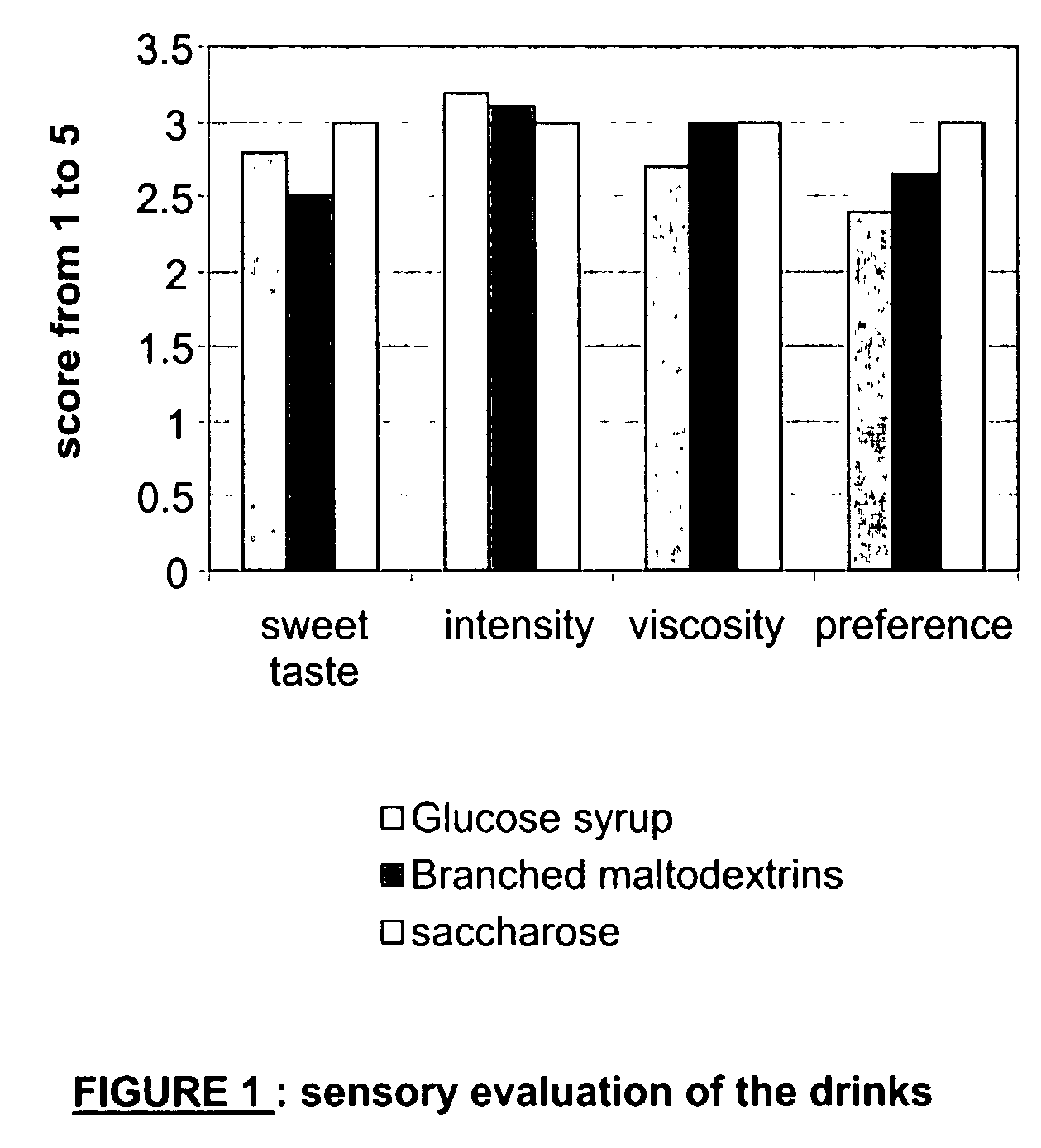Fibre-enriched drinks
a fibre-enriched drink and low-calorie technology, applied in the direction of sugar food ingredients, food preparation, food ingredients, etc., can solve the problems of inability to substitute, difficulty in adjusting, and difficulty in adjusting
- Summary
- Abstract
- Description
- Claims
- Application Information
AI Technical Summary
Benefits of technology
Problems solved by technology
Method used
Image
Examples
example 1
Preparation of Fizzy Soft Drinks
[0032]Fizzy soft drinks containing, on the one hand, sucrose, and, on the other hand, glucose syrup and branched maltodextrins as a complete substitute for sucrose, are prepared.
[0033]Quantities in grams per 1 liter of drink:
[0034]
Trial 2ControlTrial 1(according to(sucrose)(glucose syrup)the invention)Sucrose100Glucose syrup86.42Branched73.68maltodextrinsAspartame0.0780.118Acesulfame K0.0780.118Lemon flavour0.70.70.7Citric acid1.91.91.9(dry)Sodium benzoate0.090.090.09(dry)Carbonatedqs 11qs 11qs 11water at 4° C.Sucrose: sieved manufacturer's sugar (BEGHIN-SAY)Glucose syrup: FLOLYS ® E7081SAspartame: NUTRASWEETAcesulfame K: HOECHSTLemon flavour: AG 31711 (QUEST)
[0035]The branched maltodextrins present between 15 and 35% of 1→6 glucoside linkages, a reducing sugar content of between 2 and 5%, a polymolecularity index of less than 5, and a number-average molecular mass Mn of between 2 000 and 3 000 g / mol:
[0036]
Reducing sugars 2.3Mn (g / mol)2 480Mw (g / mol...
example 2
Study of Stability in Solution
[0045]In order to assess the stability of the branched maltodextrins in the drinks, solutions are prepared at different pH values, containing either fructooligosaccharides (ACTILIGHT 950P or RAFTILOSE P35), or branched maltodextrins in accordance with the invention.
[0046]The variation in the molecular masses of these oligosaccharides in solution is measured during storage by steric exclusion followed by differential refractometric detection.
[0047]The results are illustrated in FIG. 2.
[0048]In the case of the branched maltodextrins, a very slight effect of the acidification of the solutions is observed. There is therefore a slight hydrolysis at the very acidic pH value (less than 3) which results in a variation of the molecular weight towards lower values. After two weeks of storage, the differences are not greater than those observed immediately after acidification. After 1 month of storage, only the values obtained for the very low pH values (less than...
example 3
Stability After Pasteurization
[0051]Fruit juices are prepared comprising branched maltodextrins according to the invention, hydrogenated or otherwise, which are subjected to a pasteurization treatment for 17 minutes at 74° C. A control without branched maltodextrins and a control comprising fructooligosaccharides are also prepared. The contents are compared before and after treatment, as well as after storage. All the fruit juices have a pH of 3.8.
[0052]The results are given by the following table:
[0053]
7% hydrogenatedbranchedmaltodextrins7% branchedHydro-7%maltodextrinsgenatedfructooligo-BranchedbranchedsaccharidesCONTROLmalto-malto-(ACTILIGHT ®)SucroseSucrosedextrinsSucrosedextrinsSucroseFOSBefore2.52.47.02.16.82.36.7pasteurizationAfter1.41.67.01.66.82.44.5pasteurizationAfterndnd6.9nd6.93.82.4pasteurization +1.5 monthsAfter1.51.57.11.27.13.41.7pasteurization +3 months
These results demonstrate the absence of degradation of the branched maltodextrins according to the invention, hydr...
PUM
| Property | Measurement | Unit |
|---|---|---|
| volume | aaaaa | aaaaa |
| number-average molecular weight | aaaaa | aaaaa |
| pH | aaaaa | aaaaa |
Abstract
Description
Claims
Application Information
 Login to View More
Login to View More - R&D
- Intellectual Property
- Life Sciences
- Materials
- Tech Scout
- Unparalleled Data Quality
- Higher Quality Content
- 60% Fewer Hallucinations
Browse by: Latest US Patents, China's latest patents, Technical Efficacy Thesaurus, Application Domain, Technology Topic, Popular Technical Reports.
© 2025 PatSnap. All rights reserved.Legal|Privacy policy|Modern Slavery Act Transparency Statement|Sitemap|About US| Contact US: help@patsnap.com


